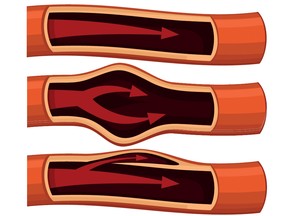The first patient who underwent the procedure at Sacre-Cour Hospital was back home after 48 hours, while the standard surgery usually requires a stay of seven to 10 days.

Two surgeons at Sacré-Coeur Hospital recently became the first in Quebec to use a new technique to treat the conditions of aortic aneurysm and dissecting aorta without traditional open-heart surgery.
It considerably reduces risk to patients and shortens the length of their hospital stay and convalescence period. It also represents new hope for patients who, until now, were not suitable candidates for open-heart surgery because their hearts were too weak.
Advertisement 2
THIS CONTENT IS RESERVED FOR SUBSCRIBERS ONLY
There with you then. Here with you now. As a critical part of the community for over 245 years,The Gazette continues to deliver trusted English-language news and coverage on issues that matter. Subscribe now to receive:
- Unlimited online access to our award-winning journalism including thought-provoking columns by Allison Hanes, Josh Freed and Bill Brownstein.
- Opportunity to engage with our commenting community and learn from fellow readers in a moderated forum.
- Unlimited online access to the Montreal Gazette and National Post, including the New York Times Crossword, and 14 more news sites with one account
- Support local journalists and the next generation of journalists.
- Montreal Gazette ePaper, an electronic replica of the print edition to view on any device, where you can share and comment..
SUBSCRIBE TO UNLOCK MORE ARTICLES
There with you then. Here with you now. As a critical part of the community for over 245 years,The Gazette continues to deliver trusted English-language news and coverage on issues that matter. Subscribe now to receive:
- Unlimited online access to our award-winning journalism including thought-provoking columns by Allison Hanes, Josh Freed and Bill Brownstein.
- Opportunity to engage with our commenting community and learn from fellow readers in a moderated forum.
- Unlimited online access to the Montreal Gazette and National Post, including the New York Times Crossword, and 14 more news sites with one account
- Support local journalists and the next generation of journalists.
- Montreal Gazette ePaper, an electronic replica of the print edition to view on any device, where you can share and comment..
REGISTER TO UNLOCK MORE ARTICLES
There with you then. Here with you now. As a critical part of the community for over 245 years,The Gazette continues to deliver trusted English-language news and coverage on issues that matter. Create an account or sign in to continue with your reading experience.
- Access articles from across Canada with one account.
- Share your thoughts and join the conversation in the comments.
- Enjoy additional articles per month.
- Get email updates from your favourite authors.
Article content
Article content
The procedure of physician-modified endovascular grafts consists of making holes in a metal device known as a stent, used normally by doctors to treat potentially fatal conditions of the aorta.
“It means we are able to treat patients in all kinds of scenarios, but also in emergencies, with stents to which we already have access,” said Dr. William Fortin, a vascular surgeon at the Université de Montréal-affiliated hospital.
The modified stents can be used in blood vessels branching off from the aorta toward the head and the arms, he said.
These vessels, said colleague Dr. Marina Ibrahim, a heart surgeon, branch from the transverse aorta: one vessel toward the right arm, one toward the left arm and two toward the head.
“This type of surgery has an extremely high risk of stroke,” she said. “The surgery requires stopping blood flow temporarily and, during this time, perfusion to the brain is suspended. We protect the brain, but the risk of stroke is very significant.”
While the technique is relatively complex for doctors, Fortin said, “the benefits for the patient are clear from the outset, notably in terms of reducing surgical risks and the length of convalescence.”
By signing up you consent to receive the above newsletter from Postmedia Network Inc.
Article content
Advertisement 3
Article content
It also represents hope for patients who are not candidates for traditional surgery.
“We look for minimally invasive options for these patients who could not withstand traditional open-heart surgery” he said. “We want to offer these patients an option other than waiting for their pathology to carry them off.”
The technique, developed in France about a decade ago, allows for the timely treatment of patients who often don’t have the luxury of waiting several weeks for a stent to be made to measure: This includes patients with a major aortic aneurysm or those whose aorta is dissected.
“The novelty of this technique is we can use a stent we already have and adapt it to the specific anatomy of each patient,” Fortin explained. “We can treat anyone, anywhere, when they need it.”
That said, he added, these procedures, however they are performed, involve significant risks for the patient “and we have to make sure we have the right option for everyone.”
The first patient who underwent the procedure at Sacré-Cour was back home after 48 hours; the standard surgery usually requires a hospital stay of seven to 10 days.
“It represents a big step forward, technically and professionally,” Ibrahim said. “It works and we can start to use the technique for many patients.”
Related Stories
Advertisement 4
Article content
Article content






![KOOLmouse [ Optical 2.4G Wireless Mouse ] [ Green Mint Gold Heart Love Stripes White ] KOOLmouse [ Optical 2.4G Wireless Mouse ] [ Green Mint Gold Heart Love Stripes White ]](https://cheapestgadget.com/wp-content/uploads/2021/09/KOOLmouse-Optical-24G-Wireless-Mouse-Green-Mint.jpg)